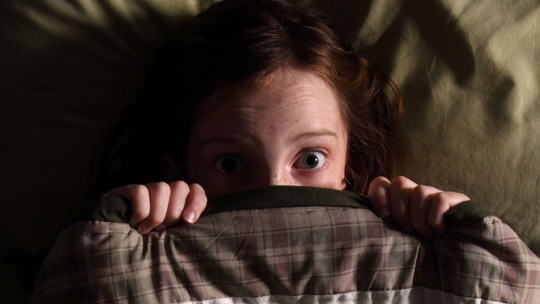
Sasha is watching a movie. In it, a person slips and accidentally pushes another person who falls down a ravine. For Sasha, the movie ends at that moment, she cannot refocus her attention on what is happening. In her mind there are only images of people falling off precipices, cliffs, floors or slopes and in all of them you can see how the person pushes them, not accidentally, but deliberately.
Seeing that scene, Sasha’s mind begins to generate an internal dialogue. “Wow, what a badass! Although this could be done by a person voluntarily, anyone is a potential pusher, anyone, it could be ME.”
From that moment on, the images do not stop in his head, he tries to distract himself and not think about them, but they are unstoppable. She’s afraid, she’s started to think that someone who can imagine pushing another person into the abyss must have a killer instinct.
Faced with that level of suffering, he begins to truly panic about his thoughts, he fears thinking. And in his effort to distract his thinking from it and avoid it, he constructs what we call a phobia of impulsion.
Fear that turns into panic or pathological anxiety
The human being’s ability to evaluate the severity of a danger, that is, how he perceives reality, influences his ability to control and reduce the intensity of his emotional response. The individual interpretation of the information received plays a crucial role in the level of anxiety experienced in this situations.
When we perceive danger, the body activates the “fight, freeze or flight” response, manifesting symptoms such as increased heart rate and blood pressure, dilation of the pupils, rapid breathing, redistribution of blood flow to the muscles, activation of the sympathetic nervous system and greater mental alertness.
This is accompanied by muscle preparation, sweating to regulate temperature and temporary inhibition of non-essential functions such as digestion. These changes seek to prepare the body to face the threat effectively.
In a phobic disorder, the phobic reaction occurs when faced with a given stimulus the person experiences a disproportionate fear that activates innate defense mechanisms. All the physiological activation that these stimuli cause as if one were in real danger, in the absence of this, do not help to react in a functional way. Physiological sensations find no use and, therefore, generate a discomfort that we call pathological anxiety.
How does impulse phobia work?
Impulsive phobia, also known as fear of losing control or performing impulsive actions, is a type of anxiety disorder characterized by the persistent and overwhelming fear of act impulsively or lose control of the body, actions. People who experience this phobia are often afraid of carrying out violent, harmful or socially unacceptable acts, even, as we have discussed, when there is no logical reason to think that this will happen.
An essential characteristic of impulsive phobias is that the phobic object is the subject himself, his thoughts and distrust in the ability to maintain impulse control.
In this case, the quintessential strategy associated with phobias, avoidance, is impossible. One cannot escape from oneself and one’s own thoughts, in fact, thinking about not thinking is already thinking per se.
In a simple phobia, the person avoids and finds relief, although if they maintain this strategy over time it can end up leading them to a state of panic. If the fear is avoided, it increases. However, in the case of impulsive phobia the person cannot find that relief so the struggle with thoughts triggers obsessive functioning.
In fact, this problem is not described in diagnostic manuals under the heading of anxiety disorders, but rather obsessive-compulsive disorders. It is a phobia that triggers obsessive-compulsive functioning. This happens because the avoidant defense cannot be carried out as in simple phobias, social phobia or agoraphobia. Thus, the more the person tries to avoid the thought of it, the more it appears and in a more and more aggressive way. It’s like trying to imprison a wild animal, it fights for its freedom loudly and aggressively and manages to jump over the barriers in a voracious way.
The complexity of these obsessions is that their contents could be threatening to anyone who suffers from them. The person may end up needing to use compulsive rituals to try to silence or protect herself and others from the content of the obsessions.
For example, a person can be standing in line at the delicatessen and imagine that he hits the head of the person in front of him with a leg of ham that he has at hand. Most likely, the person will give a half smile and concentrate on observing what types of cheeses she will order. Perhaps, if the person imagines sticking the ham knife into the elderly woman who is in a wheelchair and who is next to her, she will be a little more scared of the thought, but perhaps she can leave it to a side. Now, if the person begins to wonder about the cause of such aggressive and amoral thinking, they will most likely feed the idea of being a potential murderer.
This happens because our thinking does not stop thinking, it is its function and although it is stipulated that we generate up to 60,000 thoughts a day, our mind usually discards some without us being barely aware, and of those that we are, few will hijack our full attention. However, people who suffer from this type of intrusive thoughts tend to have rapid mental activity and quickly link one idea to another, quickly examining options and details.
They fail to ignore or relativize them, they attribute an outsized importance to them From which they begin to develop authentic theories in which these types of thoughts begin to exterminate those values of kindness, family, care and love, which define their identity and the value they give to themselves.
Frightening, unpleasant and disturbing thoughts
The content of these thoughts is usually of 4 types:
Aggressive
Fear of attacking, which can go in two directions:
Sexual
Fear of having a sexual orientation with which one does not identify or any perversion, having sexual relations with strangers or any sexual activity that is considered amoral, such as the fear of becoming excited with family members, children, animals or vulnerable people.
Morales
Fear of pronouncing foul or indecent words, blaspheming shouting or carrying out obscene or inappropriate actions, such as masturbating in a work meeting or undressing in inappropriate public places.
Hypochondriacs
Fear of losing your sanity and developing a mental illness accompanied by delusions or actions that you may not be aware of or of causing illness in someone.
The strategic approach to treating impulsive phobias
An obvious solution would be to consider the thought as one of many creations that the mind produces throughout the day and, in fact, some therapeutic approaches are based on identifying those thoughts and the beliefs that support them to interpret them in a more adaptive way. That may be fine in some cases, but often it’s not enough. Let’s think about how complex it must be to let go of a thought in which one imagines oneself carrying out acts that completely deviate from one’s own ethics and morals.
Therapies whose base epistemology is systemic constructivist, that is, brief, systemic and integrative therapies work from a strategic and integrative approach, in which the intervention will be developed by developing a specific work plan for each person, a plan built ad hoc, intervening so that the person can generate an adaptive change as soon as possible. And from there, as an ancient Chinese stratagem would say, the person will have placed their foot so that the door does not close and will gradually let their entire body pass through that door that at first seemed impossible to open.
In the event that the symptoms are associated with a post-traumatic stress disorder, the intervention will be focused on processing the trauma and helping the person to process and integrate all those memories that continue to generate discomfort in the present.
Regarding the causes of the problem, From the integrative strategic therapy model, it is considered that they are multifactorial. In the absence of an obvious traumatic situation, we begin working on the problem in the present so that the person can have strategies as soon as possible to manage their discomfort, avoiding opening the doors of possible causes in the past.
The therapy will be developed by adaptively interrupting the vicious circle between the failed attempted solutions and the persistence of the problem to transform this pathological balance and recover a functional homeostasis.
When there are no control strategies yet, the treatment will be focused on the phobia of thoughts, providing the person with strategies that help them tolerate them so that they do not have so much power over them.
When there are control strategies, on the other hand, certain techniques that we build for the person will have to be carried out, so that they can free themselves from rituals and avoidance and can recover their life again. One of the techniques is reframing: during the dialogue restructurings are carried out so that the person can reposition themselves in a more adaptive way in the face of the problem. That is, we want the person to be able to perceive their problem in a way that does not make them react through their failed attempted solutions that, far from solving it, are fueling it even more.
In addressing Impulse Phobias, a crucial restructuring involves highlighting that everything constructed by the person is intended to protect, not harm. However, this form of protection, paradoxically, generates real harm both for the individual and for her relationship with the environment. This perspective can help those facing this problem recognize themselves not as potential threats, but as protective figures. And as a protective figure, we are going to help that part of the person to be able to protect better, but through exercises and therapeutic indications that will help you face your thoughts and get out of the prison of your avoidance and rituals.
Finally, we cannot forget that the approach is also systemic and that is why the family, companions, that is, people close to the environment can have an important role during the therapeutic process and on some occasions the therapist may need them to participate as if they were co-therapists. This movement always happens with the adequate and legal consent of the consultant.
When the solution becomes a problem
Of course, the intervention varies if the person has begun to use rituals or not, if they have carried out avoidance that may be isolating them from what their life and relationships were. Mainly it will be necessary to identify the circular system in which the person is imprisoned. We identify how the person is perceiving the problem and reacting to it.
For it, It analyzes what behaviors and solution strategies the person has implemented to try to solve their problem and that, if they have not worked, they become the main problem. In the words of Paul Watzlavick, “The attempted solutions become the problem.”
In impulsive phobias, it is evident when the person, with the intention of not harming anyone, locks himself in his room and stops interacting with others. Or when she begins to do rituals to calm or control that nothing bad has happened for which she is responsible.
What you do to solve the problem, if you maintain it over time, becomes the main problem.
The main solutions attempted in impulsion phobias are usually:
Avoidance
Control
Since the person cannot escape their thoughts, they can try to control the suffering in different ways:
In impulsive phobias such as OCD, intelligence puts creativity at the service of fear, but we must not forget that this creativity is also there, at the service of solutions, courage, and passion.
When our internal system should not be fighting, we can glimpse that feeling of serenity that is difficult to arrive in a forced way.
By Noemí Calvó – Co-director of the master’s degree in strategic and integrative therapy at NUS Agency. Psychotherapist specialized in Brief Strategic Therapy, psychological trauma, EMDR, founding partner at ACCIÓ Psicologia.








